Historical texts and conventional wisdom have tended to suggest that claw overgrowth in adult pigs is largely due to a lack of wear, either as a result of confinement and reduced exercise or soft ground simply not abrading the horn tissue. However, experience over several decades, and the sporadic nature of claw overgrowth individually and between farms and over time, suggests that the issue is rather more complex than simple physical wear. It is usually multifactorial. This paper looks at the background biology of the foot and explores possible causes of problems by use of case examples.
Horn growth – Anatomy and physiology

The horn of the pigs’ main claws is composed of hard keratin organised into a wall and a sole/heel. Whilst the two main claws on the front limbs are comparable in size, the outer claws of the hind limbs are considerably larger and more curved that inner (medial) claws. As a result, the outer hind claw has a greater weight bearing role. (The two accessory digits on each leg are non-weight bearing and do not have a grossly discernible wall/sole distribution. However, they can grow excessively in some situations.)
Studies have shown that the wall of the hind limb claws grows approximately 50% quicker than that of the front limb claws, perhaps leading the view that overgrowth results from lack of wear. The growth of horn in the wall arises at the coronary band (Figure 1) and is progressively pushed down towards the weight bearing surface. Thus, any interruption or change to the coronary band or its function will impact on horn growth.
![Figure 1. Coronary band [arrow]. Note uneven growth and cracking of horn.](https://www.pig333.com/3tres3_common/art/pig333/14592/coronary-band_141739.jpg?w=820&q=1&t=1653979446)
Whilst conformation and stance of the sow will vary widely, the normal stance of the front limb is more upright (vertical) than the hind limbs (Figure 2). However, the latter is highly variable. As sows age the pasterns tend to drop, which alters the angle of contact of the foot with the floor. This may in part be associated with discomfort on certain floor types (Figures 3 and 4) or simply the result of tendon stretching under load. The sloping of the hind limb may of course reduce wear, allowing overgrowth of the front of the claw, especially the outer claw (Figure 5).
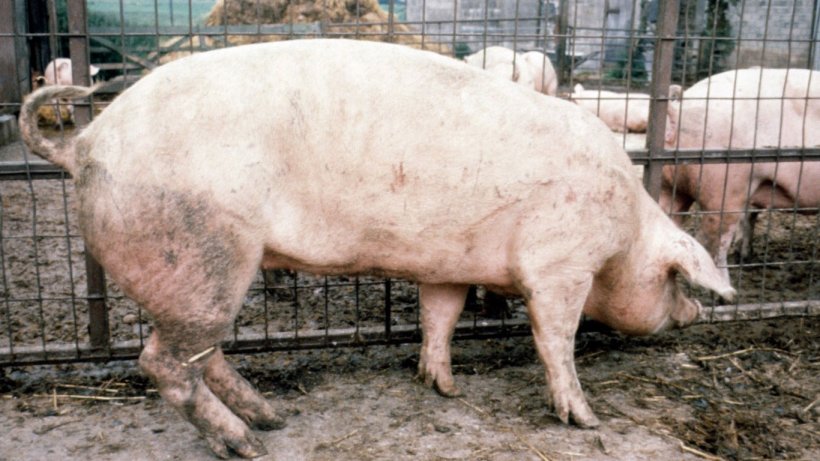
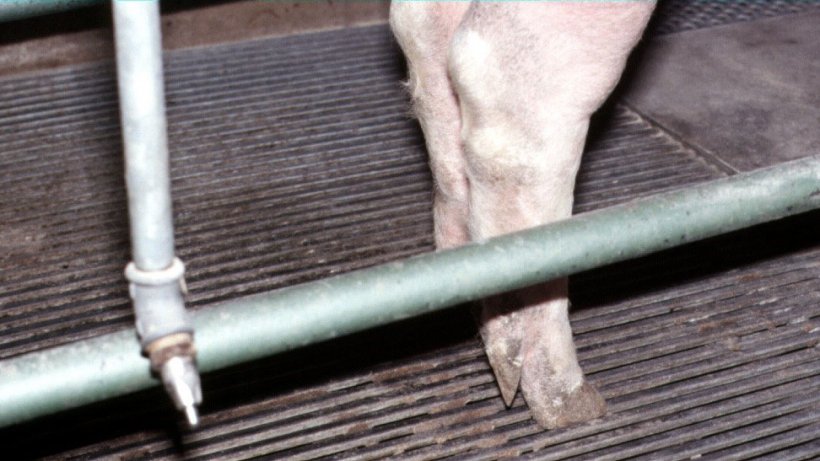
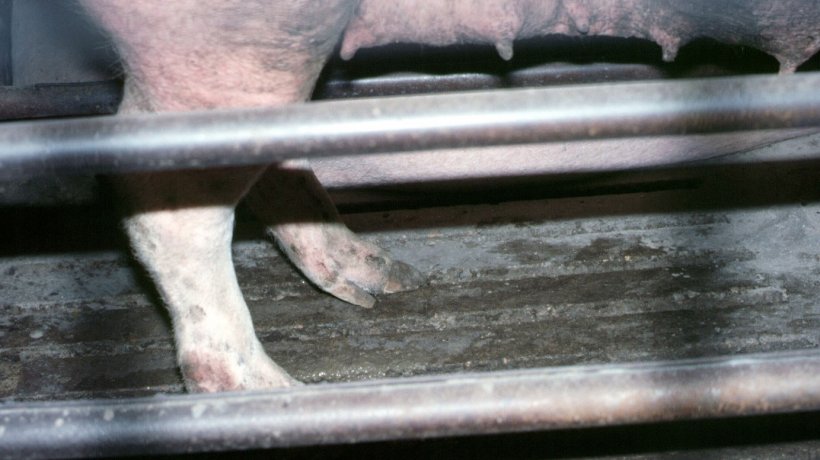

Horn growth is highly dependent on nutrition – both macro and micronutrients. As a protein, its growth will depend upon correct levels and the balance of amino acids with sulphur-based cysteine and methionine particularly important. Many micronutrients play a role in horn growth and include zinc, vitamin D, biotin and selenium. Interruption to supply or surges in supply are likely to lead to erratic horn deposition at the coronary band and this will result in uneven horn and cracks (see Figures 1 and 6).

In addition, the clinician should never forget the role vesicular diseases can play in affecting horn growth. If allowed to survive such a challenge the disruption to the coronary band will cause deformation of horn and in extreme cases “thimbling” – the complete shedding of the claw.
It should be noted that the acidosis-based laminitis well recognised in dairy cows leading to horn deformation etc has not been definitively diagnosed in the pig. (Hind gut fermentation has not been shown to significantly mirror the rumen in inducing pathological acidosis.)
Some case examples
Example 1
A newly established 600 sow outdoor herd in East Anglia, UK, developed widespread problems within the first year of production. More than 50% of second litter sows were affected by horn overgrowth, uneven horn growth and principally though not exclusively horizontal cracks in the horn. (Figures 6 &7) Previously excellent sow condition was compromised, presumed to be as a result of difficulty of accessing food.
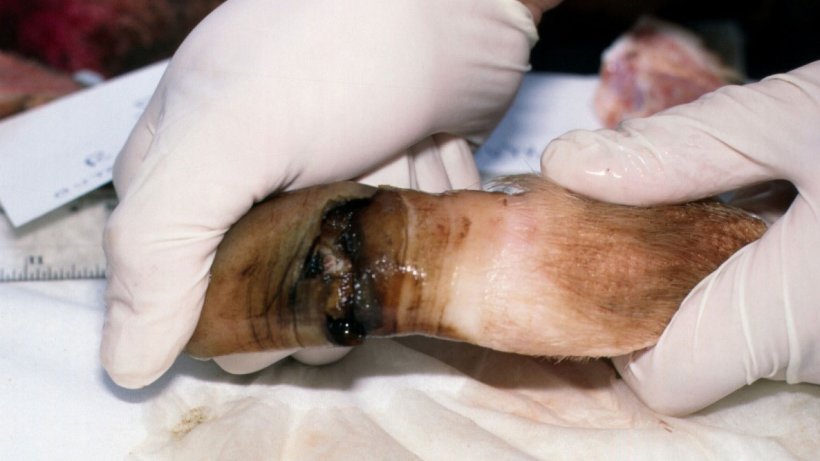
The herd had been set up on grass pasture land onto which the sows were placed in March. The grass was particularly lush and by September many sows were lame. Sows had been fed a lactator diets throughout their time on the farm. Some developed septic laminitis – the result of separation of horn and secondary bacterial disease. Forty-five second litter sows were culled due to foot lesions and a further 12 were euthanased on farm.
Several sister herds had been set up from the same source in the previous two to three years without incident and thus it was concluded that the problem was not primarily genetic in origin.
Due to the severity of the problem and the unique nature of it, several actions were taken.
- Culling of affected animals.
- Moving the whole herd onto a new field, from which a winter wheat crop had recently been removed (i.e. remove access to pasture).
- Separation of sow diets to provide a high energy/high protein lactator (18% CP) alternating with a lower energy low protein (14% CP) dry sow ration. Feed levels were reviewed and recalibrated.
- Supplementation of both sow rations with 40gm/T of a 1% Biotin premix.
Interpretation
The lesions seen were not typical of biotin deficiency (and up until the foot problems fertility had been excellent) but biotin supplementation was deemed to be prudent.
Whilst the pasture grass was not analysed it was presumed that, combined with a high protein intake during gestation due to a one diet approach, the crude protein intake was both excessive and unbalanced.
Within 6 months of the changes listed, including culling of a further 80 animals at weaning, the problems resolved, and the herd went on to produce normally with minimal foot problems.
Example 2
A 250 sow indoor breeder feeder farm with modest levels of productivity was found to have an increasing number of older sows developing “slipper feet” affecting both front and back legs. The problem had come to a head following culling of an affected sow and a report to government authorities on the grounds of welfare. The severest cases seen on farm are shown in Figures 8 and 9. In the former, clear cracking of the claws is evident.
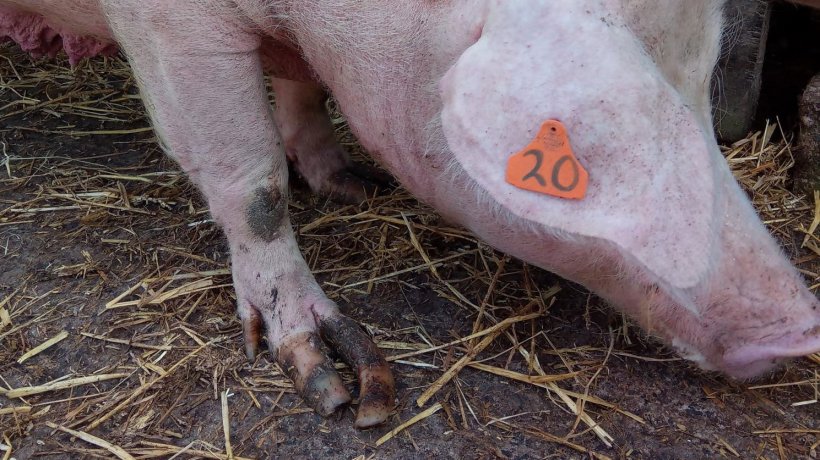
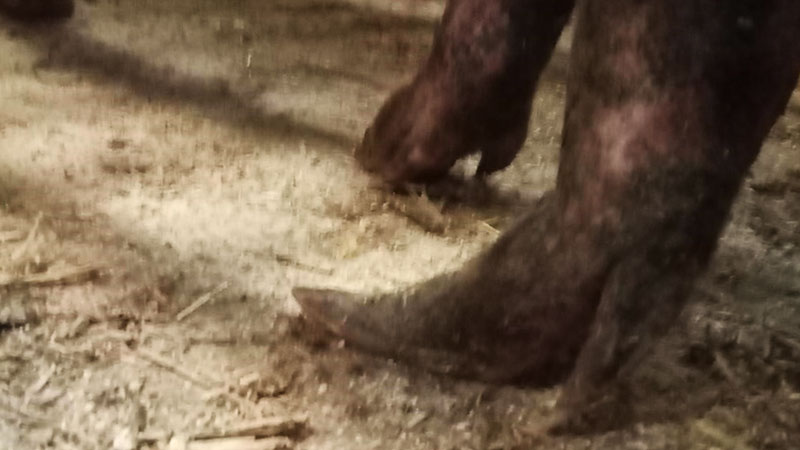
The farm is entirely straw based with dry sows kept in small groups in kennels within a barn, with a scrape through dung passage. The herd has existed for 20 years with replacement gilts produced by a homebred criss-cross mating programme. The problem had not been seen or reported prior to early 2018.
An audit of the farm revealed 9 sows with what were deemed to have pathological overgrowth of claws, at least 3 of which were deemed to be unsuitable for submission to the abattoir for culling and required on farm euthanasia. All cases were fifth parity or above.
The breeding company supplying semen for the replacement service programme argued that this was not a genetic problem.
The farm has produced its own diet with formulations set by an independent nutritionist. Whilst 2 separate sow diets were used for lactation and gestation, the dry sow diet was formulated on cost grounds to contain 16% CP. Apparently by increasing the total protein, the cost of supplementing individual amino acids could be reduced. (The lactator ration contained a more conventional 18% CP.)
It was also alleged that at some point previously the diet fed to replacement gilts had been amended against advice to save cost, and it was suggested that underfeeding of gilts in the development phase around first service had an impact on the fat pad at the heel, undermining its deposition and thus altering the gait of the young animals. It was clearly too late to either investigate or observe this change, but it may have coincided with the affected animals when they were first reared.
As no problems were identified in the younger animals it was deemed to be unnecessary to make any major changes to nutrition or environment. Culling or euthanasia of the affected animals as their last litter was weaned, removed affected animals and to date no further problems have been reported.
Example 3
As a review of affected sows in confined accommodation (stalls or tethers) it is noteworthy that this system was banned in the UK in the late 1990’s. Prior to that time most farms operated a single sow diet system and it can only be speculated that rather than the regular overgrown back feet in particular being due to the confinement per se it may have been in part due to the compromise to nutrition in using a single sow diet and failing to provide for the exact requirements of the sow at different stages of lactation.
Conclusion
From the veterinary clinician’s perspective overgrowth of claws in sows represents both a welfare and an economic insult. Whilst many herds may encounter occasional individual animals affected – which potentially may be treatable by foot trimming – outbreaks present more challenging consideration. The overgrowth of horn of the claw leading to slipper feet, cracking or separation, and secondary septic laminitis has a multifactorial origin in which
- Nutrition
- Genetics
- Environment and floor conditions
- Exercise
- Disease
- Age
may all play a part. Certainly, the traditional approach of blaming a single factor such as ‘genetics’ or ‘lack of wear’ would appear to be flawed.





